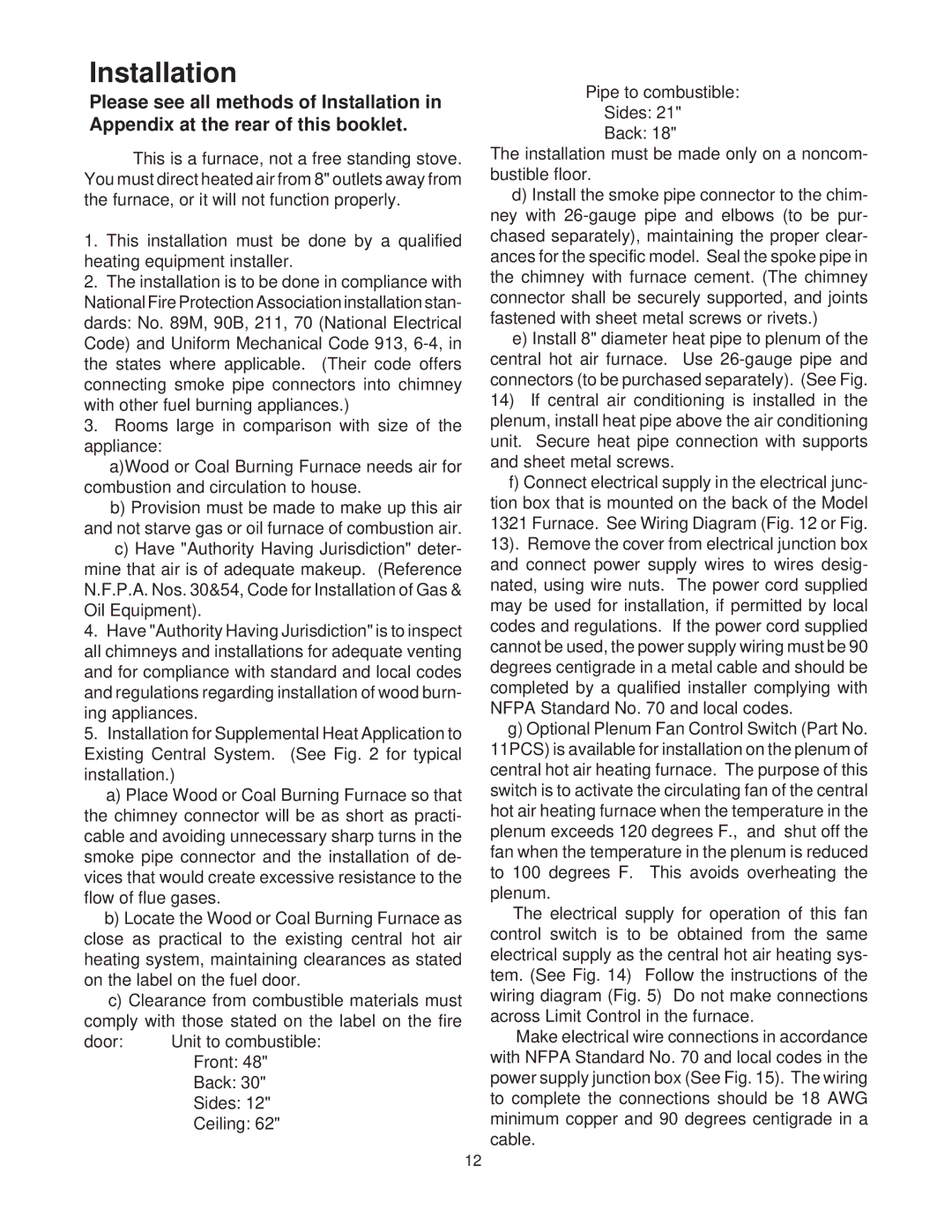Installation
Please see all methods of Installation in Appendix at the rear of this booklet.
This is a furnace, not a free standing stove. You must direct heated air from 8" outlets away from the furnace, or it will not function properly.
1.This installation must be done by a qualified heating equipment installer.
2.The installation is to be done in compliance with National Fire Protection Association installation stan- dards: No. 89M, 90B, 211, 70 (National Electrical Code) and Uniform Mechanical Code 913,
3.Rooms large in comparison with size of the appliance:
a)Wood or Coal Burning Furnace needs air for combustion and circulation to house.
b)Provision must be made to make up this air and not starve gas or oil furnace of combustion air.
c)Have "Authority Having Jurisdiction" deter- mine that air is of adequate makeup. (Reference N.F.P.A. Nos. 30&54, Code for Installation of Gas & Oil Equipment).
4.Have "Authority Having Jurisdiction" is to inspect all chimneys and installations for adequate venting and for compliance with standard and local codes and regulations regarding installation of wood burn- ing appliances.
5.Installation for Supplemental Heat Application to Existing Central System. (See Fig. 2 for typical installation.)
a)Place Wood or Coal Burning Furnace so that the chimney connector will be as short as practi- cable and avoiding unnecessary sharp turns in the smoke pipe connector and the installation of de- vices that would create excessive resistance to the flow of flue gases.
b)Locate the Wood or Coal Burning Furnace as close as practical to the existing central hot air heating system, maintaining clearances as stated on the label on the fuel door.
c)Clearance from combustible materials must comply with those stated on the label on the fire
door: | Unit to combustible: |
| Front: 48" |
| Back: 30" |
| Sides: 12" |
| Ceiling: 62" |
Pipe to combustible: Sides: 21"
Back: 18"
The installation must be made only on a noncom- bustible floor.
d)Install the smoke pipe connector to the chim- ney with
e)Install 8" diameter heat pipe to plenum of the central hot air furnace. Use
14)If central air conditioning is installed in the plenum, install heat pipe above the air conditioning unit. Secure heat pipe connection with supports and sheet metal screws.
f)Connect electrical supply in the electrical junc- tion box that is mounted on the back of the Model 1321 Furnace. See Wiring Diagram (Fig. 12 or Fig.
13).Remove the cover from electrical junction box and connect power supply wires to wires desig- nated, using wire nuts. The power cord supplied may be used for installation, if permitted by local codes and regulations. If the power cord supplied cannot be used, the power supply wiring must be 90 degrees centigrade in a metal cable and should be completed by a qualified installer complying with NFPA Standard No. 70 and local codes.
g) Optional Plenum Fan Control Switch (Part No. 11PCS) is available for installation on the plenum of central hot air heating furnace. The purpose of this switch is to activate the circulating fan of the central hot air heating furnace when the temperature in the plenum exceeds 120 degrees F., and shut off the fan when the temperature in the plenum is reduced to 100 degrees F. This avoids overheating the plenum.
The electrical supply for operation of this fan control switch is to be obtained from the same electrical supply as the central hot air heating sys- tem. (See Fig. 14) Follow the instructions of the wiring diagram (Fig. 5) Do not make connections across Limit Control in the furnace.
Make electrical wire connections in accordance with NFPA Standard No. 70 and local codes in the power supply junction box (See Fig. 15). The wiring to complete the connections should be 18 AWG minimum copper and 90 degrees centigrade in a cable.
12
